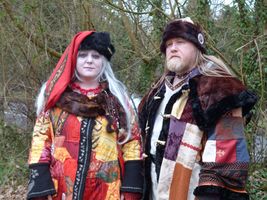Varushka religious beliefs
No edit summary |
No edit summary |
||
| Line 1: | Line 1: | ||
{{CaptionedImage|file= | {{CaptionedImage|file=Vartansy2.jpg|width=267|align=right}} | ||
Priests in Varushka are considered to be (or seek to be) [[wisdom|wise]], and are generally either physically old or possessed of an “''old spirit.''” These wise ones are the repositories of wisdom in a community. While many consider themselves priests, and several are magicians, anyone can be a wise one simply by dint of offering good advice and keeping a close eye on moral concerns. | Priests in Varushka are considered to be (or seek to be) [[wisdom|wise]], and are generally either physically old or possessed of an “''old spirit.''” These wise ones are the repositories of wisdom in a community. While many consider themselves priests, and several are magicians, anyone can be a wise one simply by dint of offering good advice and keeping a close eye on moral concerns. | ||
Revision as of 13:31, 25 March 2013
Priests in Varushka are considered to be (or seek to be) wise, and are generally either physically old or possessed of an “old spirit.” These wise ones are the repositories of wisdom in a community. While many consider themselves priests, and several are magicians, anyone can be a wise one simply by dint of offering good advice and keeping a close eye on moral concerns.
Elder wise ones are particularly respected, but there are wise ones of all ages. As a wise one grows older, they traditionally take on young apprentices who help them with their growing infirmity and in return are schooled in the ways of wisdom and virtue.
The most important role of the wise ones is to help people fend off the monsters of Varushka. Few wise ones fight the monsters directly; rather they teach people how to recognise them and protect themselves. They rally the whole vale when the monsters come, sharing with them the benefit of their experience and common sense. It is more important for a wise one to recognise and think their way around a problem than it is for them to memorize chunks of historical lore.
Wise ones recognise the danger of judging by appearances. There are plenty of stories where a wise child defeats a monster by refusing to trust the evidence of their eyes. Some wise ones emulate this by blinding themselves – not literally, but by blindfolding themselves when they are about official business. Forced to rely on other senses, they claim that they become adept at separating truth from lies – there is a common conceit that by blinding the eyes of the body, the eyes of the soul open wider allowing the wise one to see things as they truly are. A few wise ones never remove their blindfolds, living their entire lives in darkness and cultivating the “inner vision” that helps them hone their insight into the souls of others.
There is no official test to become a wise one – the title is an honorific either claimed or bestowed by one's peers. One becomes a wise one by being treated as a wise one and included in the counsels of the other wise ones.
The Virtuous Animals
Varushkans believe that most animals display one or more of the great Virtues. In particular they know that symbols or drawings of a creature can contain some of its power, so many Varushkans decorate their belongings with images of animals whose virtues they wish to emulate. The virtuous animals are also seen in Varushkan heraldry and art, as well as being worn as charms, belt buckles or embroidered patches.
Wisdom is usually symbolised by the spider or the squirrel. The goose and the spider (again) symbolise Vigilance. The bear and the boar symbolise Courage, and the virtue of Loyalty is associated with the hound. Deer and the eagle often symbolise the Imperial Virtue of Pride. Foxes and other animals seen as cunning symbolise Ambition, and often encourage the hero of the tale to improve their lot or that of their family. Prosperity is symbolised by bees, whose honey has a special place in Varushkan society.
Storytellers
Another common role for priests is as storytellers, following a tradition of telling instructional tales that show proper forms of behaviour and the repercussions of foolishness or vice. These stories balance optimism with harsh practicality; Varushkan religion instructs with a harder edge than some other national traditions. The custom of an older relative telling stories to the younger generation as the family gathers around the family is as old as humankind, but in Varushka it takes on additional significance.
Storytellers are often travellers, bringing spiritual support, entertainment and news of the outside world to isolated valleys, especially those without their own priests. The traditional garb of a storyteller is a brightly coloured coat of patchwork, marked with symbols and hung with trinkets, each one of which represents a story. Many storytellers use these trinkets and symbols as memory aids when telling their favourite stories. More so than other wise ones, a storyteller is likely to have a younger apprentice who learns the storytelling craft and the priestly ceremonies by travelling alongside the older priest.
...could not see the Wisdom in blindfolding oneself as some Varuskan wise ones do. So I tried it, and I will concede that I had to change the way I interacted with the world. The stories of the wise ones are steeped in virtue, and I feel they will come to accept the whole of The Way as readily as they do Wisdom. There is a matter I need to clarify, though. Is using animal symbols for the virtues a useful metaphor, or blasphemy against human virtue? I always believed it was the latter, but the practice is widespread and I cannot dissuade them against it.
Wayfarer Sarah in Epistles to the Winds of Virtue, 2 BE